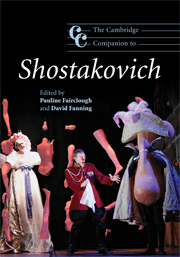Book contents
- Frontmatter
- Introduction
- PART I Instrumental works
- PART II Music for stage and screen
- 6 Shostakovich and the theatre
- 7 Shostakovich as opera composer
- 8 Shostakovich's ballets
- 9 Screen dramas: Shostakovich's cinema career
- PART III Vocal and choral works
- PART IV Performance, theory, reception
- Notes
- Select bibliography
- Index
8 - Shostakovich's ballets
from PART II - Music for stage and screen
Published online by Cambridge University Press: 28 September 2011
- Frontmatter
- Introduction
- PART I Instrumental works
- PART II Music for stage and screen
- 6 Shostakovich and the theatre
- 7 Shostakovich as opera composer
- 8 Shostakovich's ballets
- 9 Screen dramas: Shostakovich's cinema career
- PART III Vocal and choral works
- PART IV Performance, theory, reception
- Notes
- Select bibliography
- Index
Summary
Dmitry Shostakovich wrote three ballets: The Golden Age, op. 22 (1929–30), The Bolt, op. 27 (1931) and The Bright Stream, op. 39 (1935). Despite the fact that Shostakovich, though young, was already well known and showing great promise, the brief initial stage life of these scores meant that they were for a long time not properly appreciated or studied. Officially, they were identified as ‘formalistic’ and alien to Soviet art, which is partly why they remained ‘the least explored part of his musical legacy’. However, a quarter of a century after these unsuccessful premieres, fragments of Shostakovich's ballet music began to be used quite widely. Three ballet suites for small symphony orchestra were often performed at concerts and individual numbers from the scores were included in ballets subsequently created from their music from them, as will be seen.
In the 1920s and 1930s, the former Imperial Ballet went through a period of transition. Its nineteenth-century repertoire, along with its content and aesthetics, was regarded as antiquated and inappropriate for a revolutionary era. To encourage the creation of new works, at the beginning of 1929 the Leningrad Theatre of Opera and Ballet (formerly the Mariinsky) announced a competition for a new ballet scenario, set in the present day. Its demands were typical of the late proletarian period: ‘Themes must be predominantly contemporary … subject matter could be the Civil War or socialist construction … [it must be] formed from everyday material and, in part, from ethnography … [from] the peoples of the SSSR … The spectacle must make use of mass movement.’ Among the genres envisaged were the lyrico-heroic poem, comedy, satire, the contemporary fairy tale, survey and even the Soviet revue.
- Type
- Chapter
- Information
- The Cambridge Companion to Shostakovich , pp. 198 - 212Publisher: Cambridge University PressPrint publication year: 2008
- 1
- Cited by

